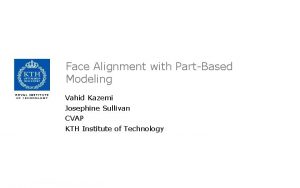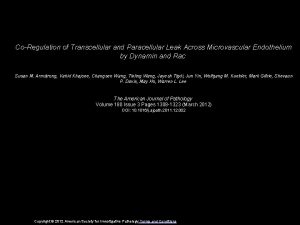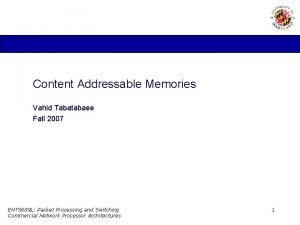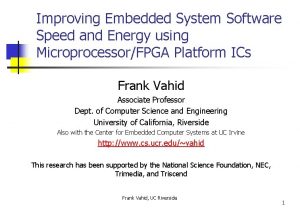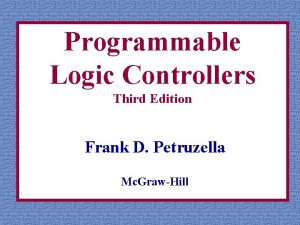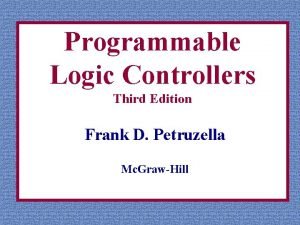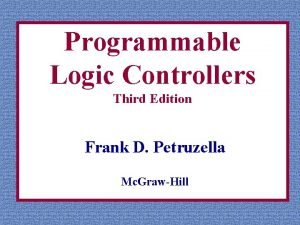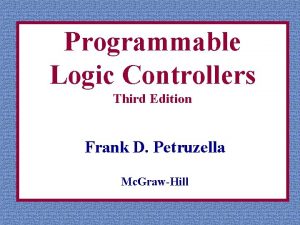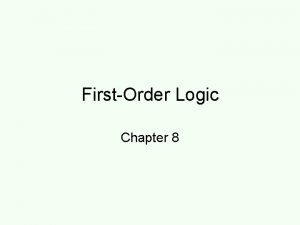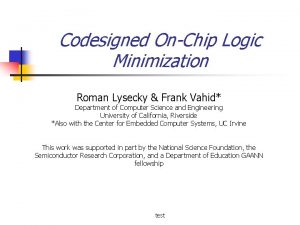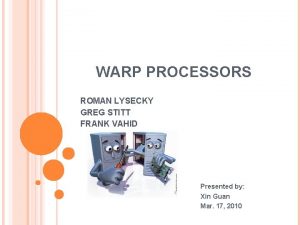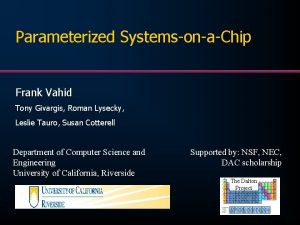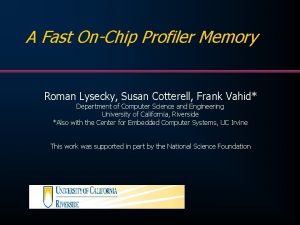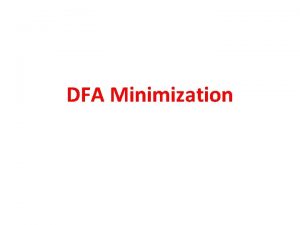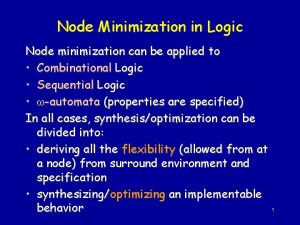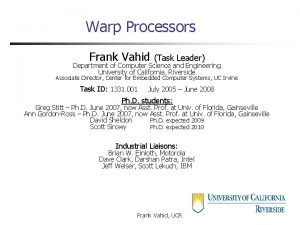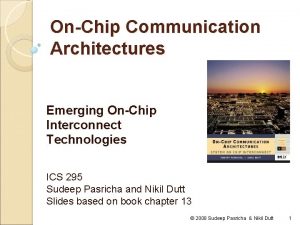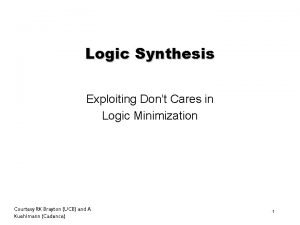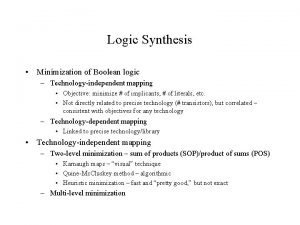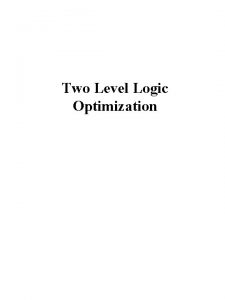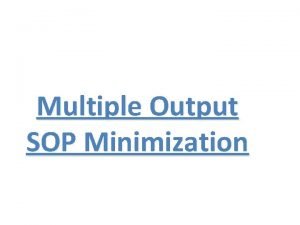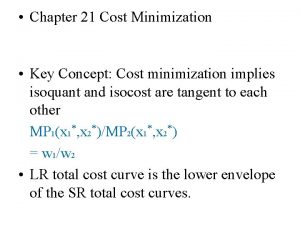OnChip Logic Minimization Roman Lysecky Frank Vahid Department


















- Slides: 18

On-Chip Logic Minimization Roman Lysecky & Frank Vahid* Department of Computer Science and Engineering University of California, Riverside *Also with the Center for Embedded Computer Systems, UC Irvine This work was supported in part by the National Science Foundation, the Semiconductor Research Corporation, and a Department of Education GAANN fellowship

Introduction • Boolean logic minimization typically used during logic synthesis • Two-level logic minimization can be considered as a general optimization technique • Many applications can benefit from using logic minimization dynamically – IP routing table reduction – Access control list (ACL) reduction 2

On-Chip Minimization Applications (IP Routing Table Reduction) 138. 23. 16. 9 Incoming IP packet 138. 23. 16. 9 Destination IP address Prefix 138. 23. 16. x Next hop Port 7 138. 23. x. x Port 5 125. x. x. x Port 3 Port 7 Lookup Destination IP in Routing Table Choose Longest Prefix Match 3

On-Chip Minimization Applications (IP Routing Table Reduction) • Longest Prefix Match – Ternary CAM (Mc. Auley & Francis, 1993) • • • Store 0, 1, * Store IP address as TCAM entry Store prefix length using the TCAM entries mask Fast Smaller hardware resources than binary CAM Very large power consumption – How can we reduce hardware resources and power consumption? 4

On-Chip Minimization Applications (IP Routing Table Reduction) • Mask Extension (Liu, 2002) – Uses two-level logic minimization – Performing minimization for each update too slow – Incremental update • Existing minimized set becomes don’t care set • New route becomes single entry in on set • Achieves an average of 50 updates/second – Not considering communication, though Original TCAM Entries # IP Addr. Mask Next Hop P 1 10011100 11111100 7 P 2 10001100 11111100 7 Logic Minimization TCAM Entries after Mask Extension # IP Addr. P 1&P 2 10001100 Mask Next Hop 11101100 7 5

On-Chip Minimization Applications (Access Control List Reduction) • Access Control List (ACL) – Used to restrict IP traffic through network routers – ACL size can range anywhere from 300 (UCR CS&E Dept. ) to 10, 000 (AOL) – Common use is to block a particular protocol or port number to avoid attacks such as Denial of Service attacks • ACL Minimization – Similar approach as used for IP routing table reduction – However, order of the list must be preserved ACL Input Format Type Protocol In IP In Port Out IP Out Port Action 6

Introduction (Off-chip Logic Minimization) Router Transmit Data to Server Proc. I$ • Slow due to communication • Sensitive to server failures • Security issues MEM Execute Minimizer D$ Server Network Router Chip Transmit Result to Router 7

Introduction (On-chip Logic Minimization) Router Initialize Minimizer I$ Proc. D$ Execute Minimizer Indicate Completion ARM 7 MEM DMA Mem. On-chip Minimizer Network Router Chip 8

On-Chip Logic Minimization Requirements • On-chip Logic Minimization Requirements – Data Memory Resources • On-chip minimization algorithms must be very memory conscious – Instruction Memory Resources • On-chip minimization algorithm must incorporate simplified approaches that result in acceptable designs – Execution time • Limited data and instruction memory will likely lead to longer execution times • Must still remain reasonable – Quality of results • Must be capable of producing solution relatively close to optimal Focus on developing an on-chip logic minimization tool that produces acceptable results with reasonable increases in execution time while using limited memory resources. 9

ROCM • ROCM – Riverside On-Chip Minimizer – Two-level minimization tool – Utilized a combination of approaches from Espresso-II (Brayton, et al. 1984) and Presto (Svoboda & White, 1979) Optimize(F, D) { Order. Cubes(F) for i=1 to |F| { c = Fi (c', W) = Iterative. Expand(F, D, c) F = (F c') - W } } Iterative. Expand(F, D, c) { W = {} c' = c for i=1 to |c| { c' = Expand(c', i) (val, W') = Valid. Expansion(F, D, c') if val = true W = W W' else Revert(c', i) } return (c', W) } 10

ROCM Results – Quality (Full Routing Table Reduction) Only 2% larger than optimal on average 11

ROCM Results – Performance (Incremental Update Execution Time) ROCM executing on a 40 MHz ARM 7 requires less than 1 second On a 500 MHz On a 40 MHz ARM 7 Sun Ultra 60 12

ROCM Results – Memory (Code Size and Data Memory Usage) Small code size of only 22 kilobytes Code Size Average data memory usage of only 1 megabyte Data Memory Usage 13

ROCM Results – Quality (Access Control List Reduction) Only 2% larger than optimal on average 14

Customizing ROCM • ROCM Customization – Beneficial to optimize an algorithm for a particular application – Customize ROCM’s data structures and algorithms for a particular input size • Require less memory • Reduce dynamic memory allocation • Improve performance – Created ROCM-32 customized for IP routing table reduction 15

Customized ROCM-32 Results (IP Routing Table Reduction) 37% reduction in execution time vs. ROCM 11% reduction in data memory usage vs. ROCM 16

Conclusions • Presented Riverside On-Chip Minimizer (ROCM) • Feasible to execute logic minimization on chip – Can be executed on an embedded 40 MHz ARM 7 in seconds for real networking problem sizes – Requires small code size (22 kilobytes) – Requires small data memory (1 megabyte) • Produces good results – On average only 2% larger than exact minimization • Shown usefulness for networking applications 17

Future Work • More Applications – May appear now that on-chip minimization is feasible • Dynamic HW/SW Partitioning – Dynamically partition executing binary to on-chip configurable logic – Logic minimization is used during the logic synthesis stage – Initial work on dynamic HW/SW partitioning presented at DAC 2003 yesterday in session 15 18
 Steiner
Steiner Cyrus vahid
Cyrus vahid Sun sülaləsi
Sun sülaləsi Www.pichakgroup.com
Www.pichakgroup.com Vahid kazemi md
Vahid kazemi md Dr vahid khajoee
Dr vahid khajoee Vahid tabatabaee
Vahid tabatabaee Montillation of traxoline
Montillation of traxoline Vahid e5
Vahid e5 Vahid akhavan
Vahid akhavan Vahid hejazi
Vahid hejazi Frank william abagnale sr
Frank william abagnale sr Programmable logic controllers frank petruzella
Programmable logic controllers frank petruzella The programming device must be connected to the controller:
The programming device must be connected to the controller: Programmable logic controllers frank d petruzella
Programmable logic controllers frank d petruzella Programmable logic controllers frank d petruzella
Programmable logic controllers frank d petruzella First order logic vs propositional logic
First order logic vs propositional logic First order logic vs propositional logic
First order logic vs propositional logic First order logic vs propositional logic
First order logic vs propositional logic




